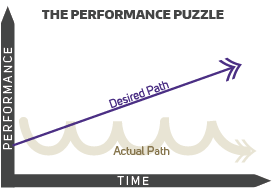
Fostering Intrinsic Motivation
Lynne Lazaroff
According to noted author Daniel H. Pink, “A lot of white-collar work requires less of the routine, rule-based, what we might call algorithmic set of capabilities, and more of the harder-to-outsource, harder-to-automate, non-routine, creative, juristic—as the scholars call it—abilities.”
The kind of work Pink describes (and the kind of workers who do it) requires managers to be less routine and more creative in how they engage and motivate people. My colleagues in POD and I have been refining how we look at engaging staff to provide more distinction between intrinsic and extrinsic motivation, as well as between “satisifiers” and “motivators,” and to help managers better align their approach with today’s workforce. I’d like to highlight some aspects of our new framework for examining motivation, which we’ll debut in SLP Level 1 this fall.
Hiam’s Performance Puzzle
Author Alexander Hiam first exposed me to the concept of intrinsic motivation, which I think it’s safe to say is now the gold standard of employee motivation. Before we talk about how to motivate, let’s look at Hiam’s Performance Puzzle to help determine why leaders need to take an active role in motivating employees:

In Hiam’s view, most employees perform on the actual rather than the desired path, and instances of higher performance are based on attempts to avoid negative consequences. As the diagram shows, employees on the actual path perform with repeated peaks and valleys over time. Performance might improve when the boss is in the office and decline when the boss is offsite, or get better leading up to the annual review period and then worsen again once the review forms have been completed and signed.
Alternatively, employees on the desired path put forth their all and do so consistently because they feel valued. These employees don’t need carrots or sticks to keep them on the desired path; they are intrinsically motivated.
Motiving Today’s Workforce
Compared with the Industrial Age, which was focused on production, many people in the U.S. today are doing work that requires a higher level of focus and creativity. This includes so-called knowledge workers but extends to anyone on your team who is solving problems, communicating with customers, crunching numbers, or using technology to accomplish their work. Rather than being a cog in the wheel, or part of a production line, many workers are in highly individualized jobs. As a result, the leader’s approach to managing these employees must be more creative and individualized; leaders must consider not just blanket or generic “satisfiers” but “motivators” that can resonate with each individual.
Satisfiers include everything from thanking an employee with a coffee card, throwing a pizza party to recognize a team accomplishment, or giving an employee a raise or promotion. Such satisfiers are important because they help people feel valued and good about their work and workplace, but they don’t have long-term impact. Over time, employees tend to forget what life was like before they got a raise or take those pizza parties for granted. What really gets—and keeps—people going are intrinsic motivators.
When you think of motivating employees, you might see dollar signs, which is certainly true for the aforementioned satisfiers. But intrinsic motivation doesn’t require that kind of capital; it’s about making the most of your human capital. It’s opportunity-based and relies on how leaders treat people.
What True Motivation Looks Like
Hiam breaks down motivating employees into this four-step process:
- Make the results of employees’ work more visible.
- Adjust people’s jobs so that they have an appropriate amount of challenge.
- Boost morale to maximize optimism and hope.
- Check accuracy of feedback to give them a greater sense of control over results.
This people-centric approach isn’t just theoretical. I often start classes by asking managers to identify the top traits of their “best bosses.” Interestingly, the traits I hear over and over again are actually intrinsic motivators such as the following:
- Kept me informed
- Asked my opinion
- Shared their experiences
- Let me make decisions
- Made themselves available
- Treated everyone fairly and consistently
- Provided opportunities for training, development, growth
- Treated me with respect
- Treated me as an individual
- Expressed confidence in me
When asked how bosses who behaved this way influenced them or made them feel, people frequently respond with “valued,” “important,” “like what I did made a difference,” “motivated.” Then, when asked how these feelings impacted their performance, I usually hear that people gave it their all, did whatever it took, went above and beyond.
While many forms of intrinsic motivation involve inclusionary approaches that take more planning and commitment on the part of the leader, the potential payoff is huge. If done well, the return on your investment of time and energy will be more engaged employees who are motivated to consistently perform at their peak. In other words, you’ll be able to move more employees from the actual to the desired path.
Has this primer on intrinsic motivation piqued your interest? I’d highly recommend the resources listed below for further reading. I’d also encourage you to check out POD’s new competency guide for offerings and services that can help you better motivate your team.
RESOURCES
Bersin, J. (2014, April 10) It’s Time to Rethink the “Employee Engagement” Issue. Retrieved from http://www.forbes.com/sites/joshbersin/2014/04/10/its-time-to-rethink-the-employee-engagement-issue/#3c8d82da1827
Hiam, A. (1999). Streetwise Motivating and Rewarding Employees: New and Better Ways to Inspire Your People. Holbrook, MA: Adams Media Corp.
Kruse, K. (2012, June 22) What is Employee Engagement? Retrieved from http://www.forbes.com/sites/kevinkruse/2012/06/22/employee-engagement-what-and-why/#55a40a504629
Nohria, N., Groysberg, B., Lee, L-E. (2008, July-August) Employee Motivation: A Powerful New Model. Harvard Business Review, 78-84. Retrieved from http://www.hbr.org
Pink, D. H. (2011) Drive: The Surprising Truth About What Really Motivates Us. New York, NY: Riverhead Books, A division of the Penguin Group.
Thomas, K. (2009) Intrinsic Motivation at Work: What Really Drives Employee Engagement (2nd ed.). San Francisco, CA: Berrett-Koehler Publishers.


